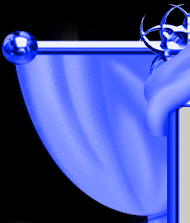Gibson Guitars
OK! I know! This website deals in "Specializing in Custom Fender Guitars." I have a few nice Gibsons that I have either sold or have tucked away I would like to show you. Some interesting history too:
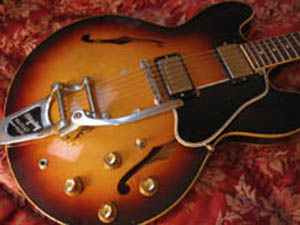
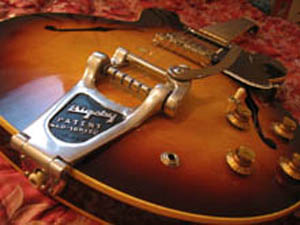
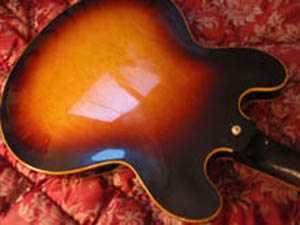
This is a completely original 1960 ES-335-TD that has not been altered or modified over the years! The ES-335 series was introduced by Gibson in 1958. In 1960 they came out with the TD series with the smaller pickguard, and the Bigsby was introduced as an option. This 335 came from the factory with the Bigsby. The first models came with the pearoid plugs where the bridge goes and then later they used a small "Custom Made" plate that covered the holes. (Here is a little info you might be interested in E = Electric; S = Spanish; 335 = model number; T = Thin; and D = Dual Pickups; thus ES-335-TD)
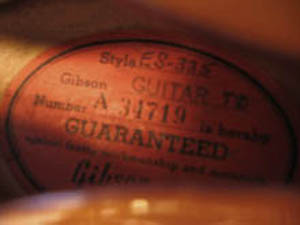
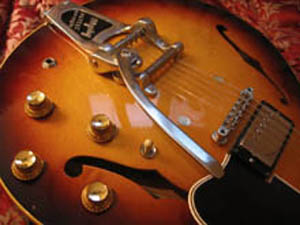
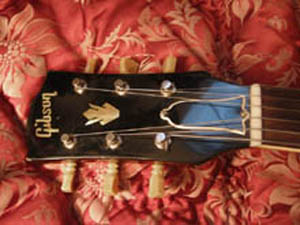
The serial number is #A 34719 indicating it was made in late 1959—the very first of the 1960 TD Series. The tuners are in perfect working order. All the controls (potentiometers), knobs, everything are as found straight from the Gibson factory—no replacements or modifications—all original. The frets show almost no sign of wear. They have never been leveled, filed or polished (or replaced).
Here is what Gruhn Guitars in Nashville wrote when I had this guitar appraised: “The instrument seems to be in exceptionally fine condition. It has a factory original Bigsby and two pearl plugs in the original stop holes in the top. This was a common procedure when Gibson received an order for a guitar with a Bigsby. In other respects, it conforms to the typical specifications of the model for the period with 16 inch wide double cutaway thin semi-hollow body constructed of laminated maple, mahogany neck, Brazilian rosewood fingerboard with white binding and pearloid dot inlays, two patent applied for humbucking pickups, beveled edge laminated black pickguard extending to the edge of the bridge position pickup, tone and volume controls of the type introduced in 1960 with metal caps, white binding on the body edges, sunburst finish, and brown original hard case with pink plush lining.”
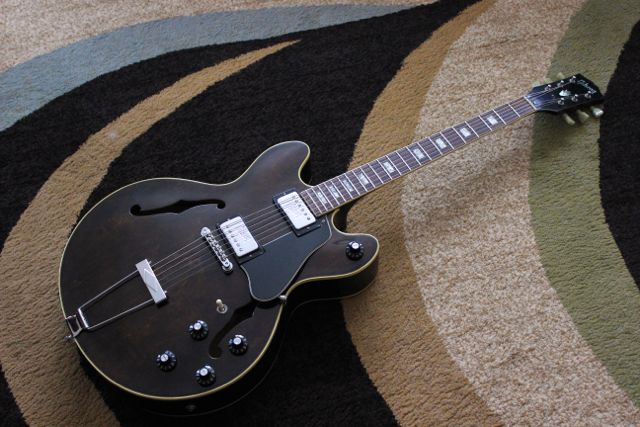
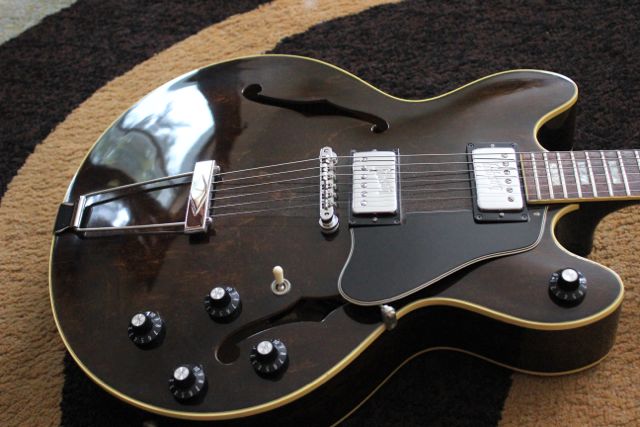
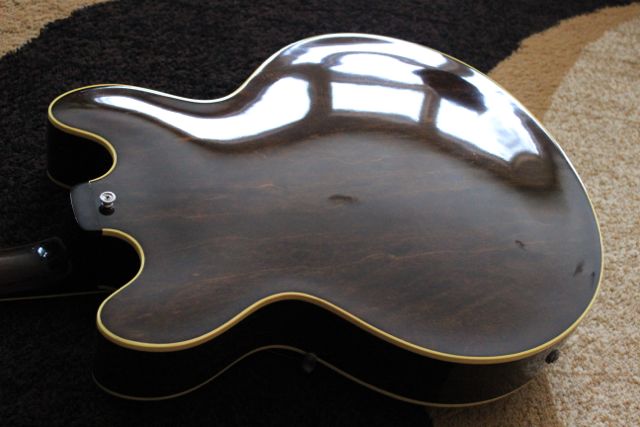
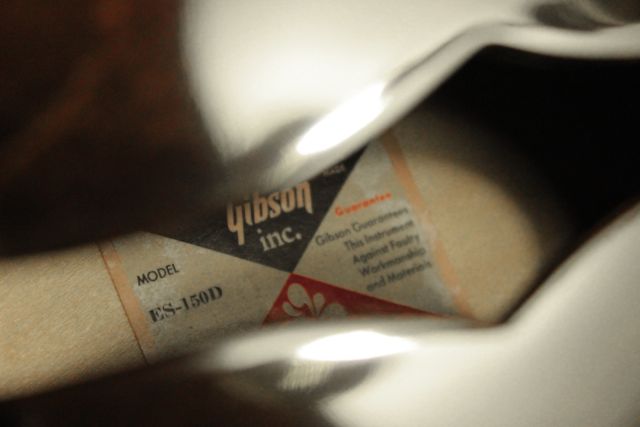
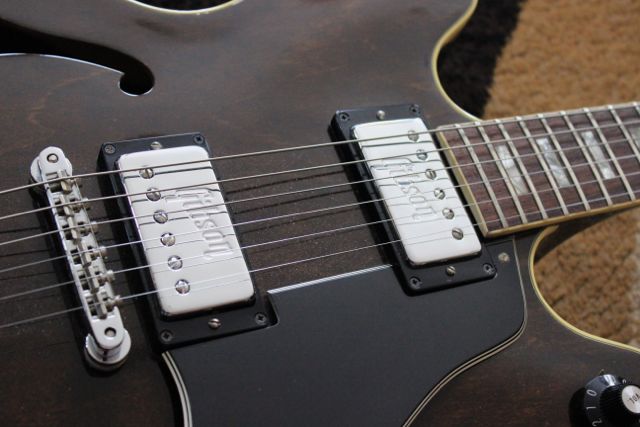
This is a 1972 GIBSON ES150D or sometimes called a ES150DC. The hollow body archtop guitar features an exclusive double Venetian cutaway design that contributes to easy playability. Again the ES stands for Electric Spanish; the "150" is the model and then the D = dual, for dual pickups. These were sometimes called an ES-150 DC with the DC standing for Double Cutaway. This guitar looks like a fat "jazzy" version of a ES335, but unlike a 335 which is a semi-hollow-body, the 150D is a full hollow-body. this one is in excellent shape with the rims and back being constructed of fine maple. It has white binding on back and top, with mother-of-pearl inlaid peghead. You will note that this model has the hum bucker pickups with GIBSON embossed on the top. The Blue Book of Guitars says it has these features: Double cutaway semi-hollow style, arched maple top, with f-holes, raised layered black pickguard, bound body, maple back/sides, with a mahogany neck, 22-fret rosewood fingerboard with pearl block inlay, tune-o-matic bridge/trapeze tailpiece, 3-per-side tuners, and chrome hardware. It also features a master volume control knob. The neck on this guitar is super slim, way slimmer than any other guitar I own. It is nice for small hands but a bigger pawed person might feel pretty confined!
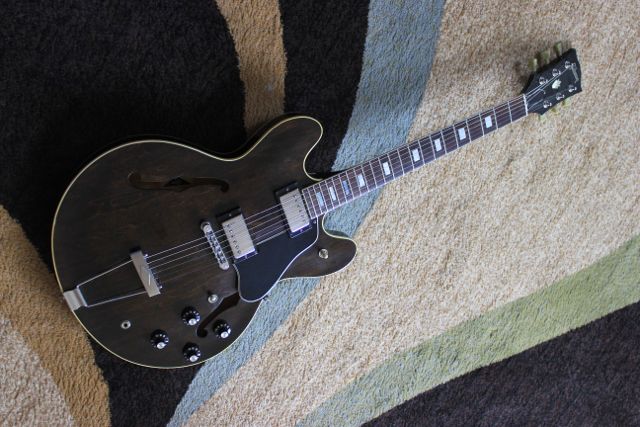
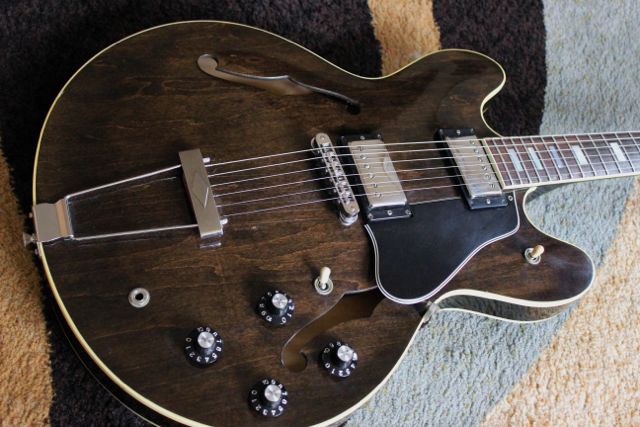
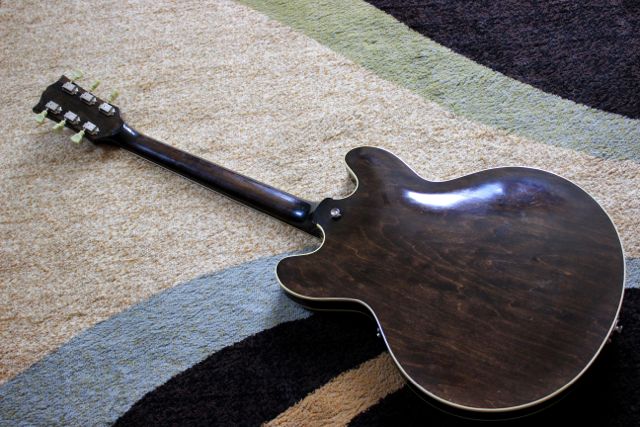
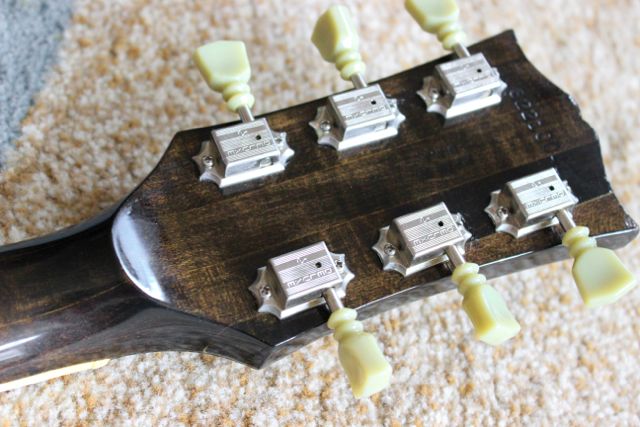
This is a 1980 GIBSON ES-335-TD. It is a soul mate for my 1972 ES150D above. This particular model has a coil-tap switch for the humbuckers. You can cut off one side of the coils to make them sound thinner, more like a single coil. I rarely use the swtich. The 335s have a big solid piece of wood running down the length of the body inside. This makes the guitar quite a bit heavier then the 150 but also prevents microphonic feedback at higher volumes. This particular year the neck came with a volute on the base of the headstock.
This is an original Gibson 1976 Bicentennial Issue Firebird—the real re-issue! These were made from late 1975 to early 1977. It has Gold plated hardware that is well worn. These are the real re-issue of the old 60s Firebirds. The Neck and the Body are made from one piece mahogany that runs the entire length of the guitar. This is what Gibson call a REVERSE STYLE. The top and bottom pieces of the body (wings as some call them) are mounted to the neck through body. This guitar resonates like crazy. Unfortunately it has a Thunderbird Bass pickguard on it as the original was replaced by a black one.
This guitar is extremely comfortable feel when you hold it on your lap, but does not stand on it’s own very well. The neck has 22 frets on a ROSEWOOD fret board. The neck is like a cross between a ES335 and a Les Paul but a little more like a baseball bat! Iit has a feel like the Jeff Beck Strats. The tuners are large gold plated Kluson banjo-style tuners on the back of the headstock. It has mini humbukers which are very powerful. The neck pickup is full sounding and the bridge has a great bite; with a three way switch.
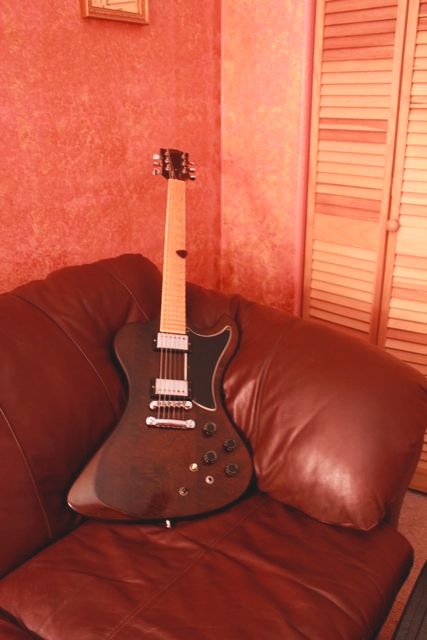
This is a 1977 GIBSON RD CUSTOM. It has a rounded body design similar to a Gibson Explorer or a Reverse Firebird. It is also super heavy! The RD line was conceived in 1975, officially introduced in 1977 and discontinued in 1982. In the RD series there was the Standard, the Custom and then the very ornate Artist model. RD stands for research and development and this range of instruments certainly was a technological leap forward for the Gibson company. The Custom had a Moog active circuit board that gave a treble boost, whereas the Artist ahad a bigger Moog board that had Expansion and Compression. Actually the Custom was the rarest and if you watch for these you will usually find the Artist or the Standard. Gibson recently released an kind of want to be "reissue" of this guitar using straight forward wiring like you would see in a Les paul type guitar.
This is a 1950 Gibson ES-140 (not to be confused with the ES-140-T, with is the thin model). It is about the same as a ES-175 except the scale length which is 2" shorter, or about the size of a Les Paul, (see pictures next to my Les Paul), but is thicker arch top hollow body. Gibson referred to this as a 3/4 or 7/8 size guitar. The neck and sides are Mahogany and the top and back are Maple. It has a 12 3/4" wide full depth body, 22 3/4" short scale, pointed cutaway, and came originally with one P-90 pickup with "dog ears" in neck position, dot fingerboard inlays, silk-screen logo, and a sunburst finish.
This guitar has been custom fitted with an additional P-90 pick-up, close to the same vintage as the original, and a three way switch. By the age and style of the pickup, it looks like it was done years ago and with the two pickups, it is more versatile in its sound, which by the way, is great, with lot’s of sustain and that original P-90 pickup sound. The tuning machines are new reproduction replacements that look original. The pick guard is custom made and fits and looks good.
This is a 1975 Gibson L-6S Standard. The L6S was a spin of the L5S Jazz guitar. The likes of Al di Meola and Carlos Santana endorsed the guitars and helped sale a lot in the early 1970s. In fact, Santana called the L6S "his rainbow." Bill Lawrence was behigned the design of the L6S guitar and also the "super humbucking" pickups. Some of you L6S owners know that the later models basicly dropped the cool L6S 6-way switching. Here is Bill Lawrence's explaination of what happened behind the scenes with the making of the L6S:
"In 1972, I was asked to design a multi-sound system for the SG Standard. This didn't make any sense to me, and after several meetings with marketing, I convinced them to introduce a completely new solid-body that offered a wide variety of different sounds. I was given a free hand as long as I observed a set production cost limit. In order to stay within that limit, I had to make use of their existing hardware, including pickup covers, and the champfered body contours I wanted were not in the budget either. Given a mere $25 more to work with, I could have made the guitar to my specs. Also, I had designed a beautiful three post lightweight bridge made of hardened stainless steel that could be converted into a trem and a two 3 position toggle switches for nine different sounds. The first 3 position switch was a pickup selector while the second was a sound selector -- position one was for Les Paul , position two for Strat, and position three for Tele sound.
"Well, I had to stay within the budget, and we ended up with a six-position rotary switch, pickups with large humbucker covers, a stock Schaller bridge with a "stop" tailpiece, and a clumsy-looking body. My original prototype had a beautiful, elegantly-shaped pickguard, but somebody changed that too. Even with these changes, the early production L6-S was still an excellent performer. When the new ownership took over, there were even more changes, and by 1976, the L6-S had become just another Les Paul-style Gibson solid-body. All that remained of my original design was the thin, lightweight body with its large cutaway for easy access to all 24 frets."
Here is how the switching works: 1: Both pickups, in series; 2: Neck pickup, alone; 3: Both pickups, in parallel; 4: Both pickups, parallel out of phase, with the neck pickup's bass response restricted thought a series capacitor. 5: Bridge pickup, alone; & 6: Both pickups, series out of phase. (The capacitor in the #4 position gives a fuller tone than the otherwise very nasal out of phase tone. The capacitor serves to limit the low end response of the neck pickup, and also phase delays the signal from that pickup, resulting in a fuller tone, not too unlike the #2 and #4 switch positions on a Fender Stratocaster guitar. Kind of a cool trick.)
This is a 1997 Sunburst HERTIAGE GOLDEN EAGLE. This beautifully handcrafted Heritage Golden Eagle has all the quality and workmanship of the older Gibson L5, namely because Heritage guitars are made by the “old boys” from the original Gibson company in Kalamazoo, Michigan.
Is it a Gibson or is it a Hertitage? :-) Well, you decide! For those that don't know, Heritage Guitar Inc. is going on 23 years old, it has achieved the status of one of the premier guitar companies in the world today. It is, in many instances, the new guitar line handled by countless vintage shops throughout the world.
The idea to start Heritage Guitar began when the Gibson Guitar Corporation closed its Kalamazoo, Michigan factory in September of 1984 and moved all production to its other plant in Nashville, Tennessee (in operation since 1975). When this took place, some of the employees were asked to move to Nashville. However, since their families had spent many years in Kalamazoo, it made it difficult to uproot and move. Therefore 3 men, Jim Deurloo, Marvin Lamb, and JP Moats, decided to start a guitar manufacturing business.
In 1985 when the company was incorporated, 2 other former Gibson Guitar Corporation employees, Bill Paige and Mike Korpak, joined as owners. Mike later left the company in 1985. The founder’s biggest resource is and was the group of craftsmen they could draw from to begin operations. The owners themselves each had in excess of 25 years of hands on experience in making guitars. To this day each of the owners is directly involved in the manufacturing of each instrument. Heritage started operations in the oldest of five buildings formerly owned and operated by Gibson Guitar Corporation. That building was completed in 1917 and has been a center for guitar manufacturing ever since. Much of the machinery that Heritage uses today was purchased from Gibson Guitar Corporation. So when you take a look at this beautiful piece, think Gibson in its glory days. The quality and workmanship of this guitar, are truly second to none and reflect the incredible history and experience of its builders.
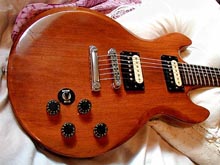
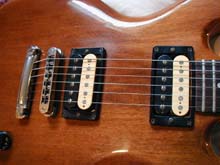
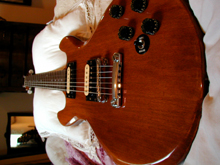
This is a 1980 Gibson ES-335-S. (The S = solid body) This was among the first made in May 21st, 1980, of the first year of production. The date is stamped inside the pot cavity when I replaced two pots with original Gibson parts. The body is heavy solid Maple with a natural Maple finish with a Mahogany neck, and a 22 fret rosewood fingerboard with pearl dot inlay. It also has a tune-o-matic bridge/stop tailpiece (all hardware is nickel), and 2 hot zebra humbucker pickups. The neck action is low and fast, like my ES-335TD. Frets are flat and somewhat wide like on the ES335 guitars of this same era. I have owned several of these and love the feel and versatility of the guitar. I have own several of these and they are great little guitars.
Made for only 3 years, from 1980 to 1983, in what Gibson introduced as the Firebrand Series (it has Gibson on the headstock burned in) it copied the shape of the historic Gibson ES-335 but is smaller and has a solid maple body. (Please see the picture next to my 1980 Gibson ES-335-TD.) It is like a cross between a double cutaway Les Paul and an SG with a slightly thinner ES-335 neck. Gibson was trying to compete with the solid body market by introducing these lower priced models. They play great and have hot pickups. There are several models; some with a brass nut, a coil tap switch and pickguards. Some were a Deluxe Model and others, like this one, were Standard Models.

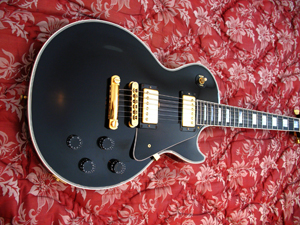
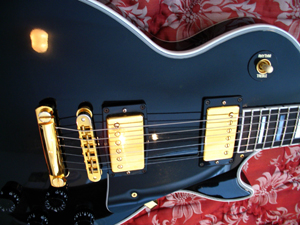
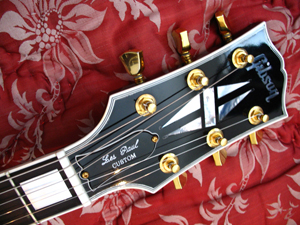
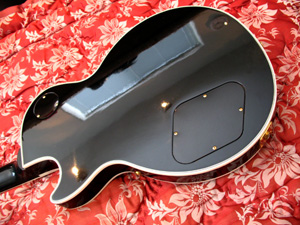
This is a Gibson 57 Les Paul Custom "Black Beauty" reissue. These come with an ebony fingerboard with low flat frets and real pearl inlays. A solid black finish with gold plated hardware. The guitar was quickly dubbed the "Fretless Wonder" because of those low frets, which made playing nearly effortless.
This is a 2004 Gibson Custom Shop ES 336 Natural. The top on this is solid Maple with Mahogany back, sides and neck. The ivory binding sets off the beautiful contrast of the dark and light colored woods. The 336 is the little brother to the ES 335—because it is much smaller than a 335 and the length of the whole guitar is shorter.
It is often call the Les Paul of the ES series because of it size, sporting a neck that feels a lot like the old Gibson SG series. The flame on this guitar is stunning. The hot 57 Burstbucker pickups kick out lots of tone.
This is a 2005 Les Paul Standard with in a AA Figure Top Black Cherry Finish (50S NE). It has all gold hardware and the pickups have been changed out with a 1981 Les Paul bridge pickup and a Lindy Fralin pickup in the neck. The gold covers were retained to preserve that "gold."
This is a 1998 USA Translucent Chicago Blue Gibson Blues Hawk. The top is Beautiful Split Maple with classy F-holes on a Poplar back body. The fingerboard is made of solid Rosewood. There are Diamond inlays on the fingerboard and the headstock. It has 22 frets. The neck has a very slight V shape like a Les Paul. This unique guitar is a blend of Gibson technologies—both old and new. It has a single cutaway, neck set, shape and feel like a Les Paul. It is semi-hollow body like a Gibson ES 335 with solid piece of wood running through the center of the body. It has a 6 way Varitone Switch like some of the old Gibson ES 345s. And is very similar to the size of the 1950's Gibson ES 140t model. Put all this together and you have a Gibson Blues Hawk.
All the Hardware is Gold Plated. The bridge is a low-profile string-through-body system, which give the guitar more resonance. The Semi-hollow body makes the guitar have great sustain. The pickups are a new version of the old P-90s found on the old Gibson Les Pauls or 1950 ES series Gibsons. These are called Blues 90s with hum canceling dummy coil.This is the best of both worlds. You get the old P-90 sound with no hum! Great for Studio work! A standard 3-way switch controls the pickups.
This is a TV Yellow Relic (faded) 2002 Gibson Les Paul Special. It comes from the factory with an aged, relic, worn look. It has all the feel and class of a Les Paul from the 1970’s. Basically in new condition, despite the factory applied relic show! The body and neck is made from solid Mahogany. It has the 1960’s slim taper neck with a 22 Fret Rosewood fret-board, with Pearloid Dots. The frets are almost new and the action is everything a Les Paul should be—fast and low.
The Electronics kick out some real vintage Gibson tone using the same pickups found on some of the high end Les Paul guitars. The neck pickup is 490R and the bridge pickup is a 498T, both being Alnico magnet humbuckers! Blues, Alternative, Rock, and even sweet jazzy sounds!
